Pears farming is an agricultural venture that has caught the interest of farmers due to its potential for good revenue and profitability. The project report on pears farming reveals that understanding the economics of pears production is essential for farmers to make informed decisions. This report focuses on the costs and profits of cultivating pears on a 1-acre farm. It examines various expenses, from land preparation to marketing, and analyses the revenue in pears farming, aiming to enhance profitability.

A critical component is the return on investment (ROI) in pears farming, which measures the financial gain relative to the amount invested. Strategies for cost reduction in pears farming are also essential to maximize profits. The discussion will include a breakdown of the 1-acre pears farming cost and the expected 1-acre pears farming profit. Furthermore, the typical 1-acre pears yield is crucial to determining the economic success of the operation.
Pears Farming Project Report
Factors Affecting Pears Farming Costs and Profits
Numerous factors influence the costs and profits in pears farming, from the variety of pears planted to the local market demands. Weather patterns, soil fertility, and water availability significantly affect the yield and quality of pears. The choice of farming methods, such as organic versus conventional, can also impact expenses and income.
To maximize profits, farmers must consider these variables carefully. Efficient management practices, market trends, and timely operations can help in cost reduction and enhance the profitability of pears farming. Moreover, addressing challenges like pests and diseases promptly reduces potential crop losses, thereby protecting revenue in pears farming.
Land Preparation and Infrastructure Costs in 1-Acre Pears Farming
The initial step in 1-acre pears farming involves land preparation, which incurs costs for clearing, tilling, and readying the soil for planting. The land preparation cost typically amounts to $4,000. This stage is crucial for ensuring a conducive environment for the seedlings to thrive. Infrastructure costs might include expenses for fencing, storage facilities, and irrigation systems, which are essential for the protection and upkeep of the pear orchard. These upfront investments are vital for the long-term success and yield of the pear farm.
Planting and Cultivation Expenses for 1-Acre Pears Farming
The planting and cultivation phase involves purchasing quality seedlings, which cost around $1,500 for an acre. The cultivation process also includes labor and materials for planting, pruning, and managing the pear trees as they grow. Proper cultivation ensures that the trees develop optimally, leading to a good 1-acre pears yield. These activities must be timed and executed efficiently to set the stage for a profitable harvest.
Irrigation and Water Management Costs in 1-Acre Pears Farming
Effective irrigation and water management are paramount in 1-acre pears farming, ensuring the trees receive the right amount of water at the right times. This can involve setting up an irrigation system and water consumption costs. Water management also plays a role in disease prevention and thus impacts the overall health and productivity of the pear trees.
In case you missed it: 1-Acre Pineapple Farming Project Report: Production Economics, Cost and Profit Analysis

Fertilizer and Pesticides for 1-Acre Pears Farming
To support the pear trees’ growth and yield, farmers must invest in fertilizers and pesticides. These inputs contribute to the health and vigor of the pear trees, which directly relates to the 1-acre pear yield. The cost of fertilizers is about $400, and an equal amount is allocated for pest control. These interventions are critical for ensuring the quality and quantity of the pears produced.
Labor and Machinery Costs for 1-Acre Pears Farming Operations
Labor and machinery are significant components of the operating costs in pears farming. This includes the labor for day-to-day operations, such as weeding, pruning, and monitoring the trees, as well as using machinery for land preparation and maintenance tasks. Efficient labor management and the judicious use of machinery can help in cost reduction in pears farming, thereby enhancing overall profitability.
Harvesting and Post-Harvest Handling Expenses for 1-Acre Pears Farming
Harvesting is a labor-intensive phase where costs include picking, sorting, and packing the pears. The harvesting expense is around $1,750 for a 1-acre farm. Post-harvest handling also involves costs for storage, packaging, and possibly refrigeration to maintain the quality of the pears until they reach the market. These steps are crucial for minimizing losses and preserving the fruit’s value.
Marketing and Distribution Costs in the 1-Acre Pears Farming
Marketing and distribution are the final steps where pears reach the buyers. These processes incur costs for transportation, market fees, and advertising, totaling approximately $250. Efficient marketing and distribution strategies can increase the revenue in pears farming by ensuring that the produce reaches the right markets at the right time and attains the best possible prices.
In case you missed it: 1-Acre Kiwifruit Farming Project Report: Production Economics, Cost and Profit Analysis

Assumption of this Pears Farming Project
This pears farming project assumes land ownership and presents a cost and profit report for a 1-acre plot. The profit calculation provided is for the first harvest, with the expectation of increased profits in subsequent harvests. It’s important to note that the profitability and costs in pears farming can vary significantly based on the region, variety of pears, time of year, cultivation practices, and market value.
1-Acre Pears Farming Cost Analysis
| Requirements | In USD |
| Land Preparation | $4,000 |
| Seedling | $1,500 |
| Fertilizers | $400 |
| Pest Control | $400 |
| Harvesting | $1,750 |
| Marketing | $250 |
| Total Costs | $8,650 |
| Sale Price per Ton | $2,500 |
| Quantity of Produce Sold | 5 tons |
| Total Revenue | $12,500 |
| Profit (Total Revenue – Total Costs) | $3,850 |
Frequently Asked Questions (FAQ) on Pears Farming
What is the Yield of Pears per Acre?
The yield of pears per acre can vary significantly based on factors like variety, climate, and farming practices. On average, a well-managed 1-acre pear orchard can produce between 15 to 20 tons of pears annually under optimal conditions.
How Much Distance Required for Pear Plantation?
For pear plantations, trees should typically be spaced 12 to 15 feet apart, with rows 20 feet apart. This spacing allows adequate sunlight and air circulation for the trees, vital for healthy growth and fruit production.
In case you missed it: 1-Acre Raspberry Farming Project Report: Production Economics, Cost and Profit Analysis

Conclusion
Pear farming on a 1-acre plot can be a profitable agricultural venture when managed effectively, with an estimated initial profit of $3,850 from the first harvest. The success of pear farming hinges on optimal land preparation, careful management of resources, and strategic marketing. However, it’s crucial to note that variables such as regional conditions, pear varieties, cultivation practices, and market demand significantly influence the costs and revenue potential of pear farming.
- Feed Your Flock for Less: Top 10 Tips to Save on Chicken Feed
- Ultimate Guide to Ossabaw Island Hog: Breeding, Raising, Diet, and Care
- Hatching Answers: The Top 10 Reasons Your Chickens Aren’t Laying Eggs
- Eggs and Economics: Breaking Down the Cost of Raising Backyard Chickens
- Defend Your Greens: Proven Methods to Keep Iguanas Out of Your Garden
- Ultimate Guide to Cinnamon Queen Chicken: A Comprehensive Guide for Beginners
- Ultimate Guide to California Tan Chicken: Breeding, Raising, Diet, Egg-Production and Care
- Ultimate Guide to Marsh Daisy Chicken: Breeding, Raising, Diet, and Care
- 10 Types of Chicken Farming Businesses You Can Start for Profits